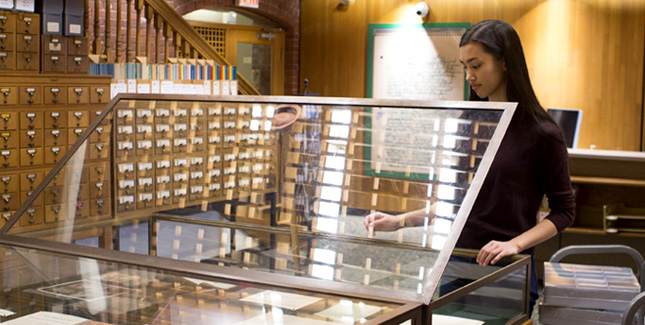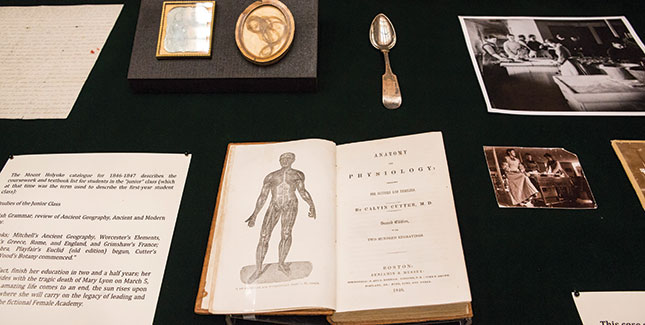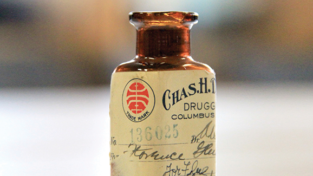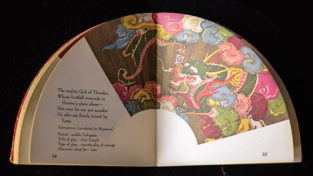Bringing History to Life
With an open-door, please-touch philosophy, Mount Holyoke’s Archives and Special Collections is helping students and alumnae connect with the College’s—and their own—rich past

Part of the Rare Book Collection in the basement of Dwight Hall.
The small brass, oak, and glass display case at the entrance to Williston Library’s main reading room is literally called the treasure case. One week you might find a handwritten draft of Wendy Wasserstein’s ’71 The Heidi Chronicles inside. The next? The school’s founding charter. Labels provide context for each exhibit, but, perhaps more important, they invite viewers to take a short walk to neighboring Dwight Hall to discover more of the gems that are permanently housed in Archives and Special Collections (ASC).
With nearly 12,500 rare books and 11,000 linear feet of archival material, the ASC itself is one of Mount Holyoke’s true treasures. Venture through the large wooden doorway and down a stately staircase to the basement of Dwight and you’ll find not only an inviting reading room lined with historical photographs and portraits but an incredible repository of the College’s history that includes photos from as far back as 1845, scrapbooks, diaries, letters, and physical objects ranging from jewelry to a student’s jump rope to the green velvet purse Mary Lyon used to collect the funds to open the Seminary in 1837.
The staff and student ambassadors who work in the ASC are on a mission to share the collections with as many students and alumnae as possible. As Leslie Fields, the head of Archives and Special Collections, explains, “A very important part of our work is to gather and care for this material. But that’s not the only part. I feel like we have an additional responsibility to share these resources and assist in making connections with people, to tell the stories that are here at Mount Holyoke.”

A student curates items on display in an exhibition about College Girl Fiction.
A Singular History
The stories that fill the Archives and Special Collections are as varied as the students, faculty, and others who have touched—and been touched by—Mount Holyoke in some way through the years. Housed in temperature- and humidity-controlled rooms since 1990 (for the Archives) and 2008 (for the Rare Book Collection), the ASC got its start in 1931 when the class of 1929 donated $2,000 to mount and bind Mary Lyon’s letters. In 1937 alumnae were encouraged to donate personal items relating to College history to celebrate Mount Holyoke’s 100th anniversary—and the collection has taken off from there. Many of the materials chronicle the College’s past but also women’s education in the US and, through the history of the Seminary’s early missionaries, around the world.
The Archives’ historical offerings are varied and rich: a letter written by Emily Dickinson, class of 1849, describing her day-to-day life at the Seminary; personal correspondence between President Mary Woolley and Professor Jeannette Marks; hundreds of scrapbooks dating as far back as the 1880s, each filled with the kind of unexpected ephemera that transports researchers into another person’s life. Meanwhile, the Rare Book Collection boasts a broad range of titles, College-related and beyond, including textbooks known to have been used during the early days of the Seminary and a Salvador Dali-illustrated version of The Divine Comedy, part of the 200-title strong Dante collection.
Martha Ackmann, an award-winning author, senior lecturer in gender studies, and former president of the Emily Dickinson International Society, brings her Emily Dickinson in Her Times seminar to the ASC each year to give context to Dickinson’s historical and educational influences. “I see the students in my class glow like light bulbs when they’re moved by the tactile experience of holding something from the Archives. They also begin to light up intellectually when they think about what they are able to do with primary materials that are not being filtered through a secondary source,” she says. Adds Fields, “Learning the history of Mount Holyoke lets students find their place here and how they’re part of it. It’s very powerful and exciting to see the resilience of the students before them and to see that there’s a model for that. They make a connection through time.”
More recent holdings—freshman handbooks, programs from junior shows, copies of campus newspapers, and yearbooks—are every bit as compelling. Nancy Loving Tubesing ’65 spent a day exploring the ASC when working on her fiftieth class reunion book committee. She read the weekly schedule of events from her four years on campus, recalled poets and politicians—Robert Frost, Martin Luther King Jr.—who visited South Hadley, and combed through photos. “It was an amazing experience of putting my college years into perspective,” she says. “There is so much there just waiting to be discovered.”

An archival storage box holds the Archives’ jewelry and pin collection, including class rings, charms, and other symbolic items.
Letting Students Take the Lead
When Fields took the helm of Archives and Special Collections in 2012, one of her goals was to give student employees as dynamic an archival and work experience as possible while, at the same time, continuing to share ASC material with the College through the ongoing exhibition program. Students now propose their own research topics, then learn to curate both major and “pop-up” exhibits—those lasting just one to two weeks—in both physical spaces and online before giving presentations to the public. The result is curriculum-to-career experience they can use on résumés and in job interviews. The exhibits are located in display cases in the library and in Dwight as well as in the ASC itself. “We have this opportunity to share our collections, and that’s a privilege and a responsibility. It makes us an activist archives and not just a storage space,” says Fields. “The students are developing real-world skills they wouldn’t be able to get at larger, more restrictive institutions.”
“The ASC was like a doorway into untold treasures. And the opportunities I got were so amazing, planning events and exhibits, things you don’t expect to do until you’re a professional in the field,” says Alena McNamara ’13, who is now pursuing a degree in library science and working at the MIT Libraries. While at Mount Holyoke, she curated an exhibit on the history of interactive books, such as pop-ups and those with quick-response (QR) codes. She also planned a Dante-themed party to raise awareness on campus of the ASC’s Dante collection, complete with Dante-inspired coloring pages for attendees to take home. “Working in the ASC made me think about how to reach out to others and let them know that everyone is welcome here. All of this intellectual history is here for everyone. It’s our cultural heritage,” she says.
Liz Knoll ’16 and Emily Isakson ’19, two of this year’s twelve workers and volunteers, spent the fall semester preparing an exhibit called College Girl Fiction. The genre, written primarily in the 1910s and 1920s and part of the Rare Book Collection, depicts the still somewhat rarefied—and mysterious to many—world of college women. Knoll and Isakson analyzed the themes of the books—including favorite Doris, A Mount Holyoke Girl—compared how male and female authors represented their protagonists, wrote copy for their exhibits, selected the design elements for their displays, and presented the materials to the public. Says Isakson of her experience, and of working in the ASC in general, “I might want to curate one day, and this gives me an opportunity to explore history. I’ve learned so many research and problem-solving skills. I’ll be able to say, ‘This is why you should hire me.’”

Materials in an exhibit case.
Putting the Special in Archives and Special Collections
“I like students to be able to smell and touch and experience the physicality of an object, especially if it’s a book from 1481. It has this amazing paper, and you have to touch it,” says Fields. To give students, and others, that experience, the Mount Holyoke ASC team takes anything but an old-fashioned approach to spreading the word about their offerings and their genuine desire to have the community utilize them. As Martha Ackmann says, “They are among the most innovative, creative, collaborative, and—most of all—fun people around the College.”
Many of those innovations are designed to meet students wherever they are on campus. “I think of it as leaving bread crumbs,” says Fields. “We try to leave little traces of the Archives around the College so that people think about us and realize that we’re here.” Take their button-making activities, a simple but effective way to connect with students and spread the word about the ASC. Fields, archivist Deborah Richards, and student workers take a portable button-making machine and copies of interesting photos from the Archives to the top of Mt. Holyoke on Mountain Day, for example, or to the library during “stress-free study breaks.”
While undergrads peruse the photos and make wearable buttons from the images, ASC staff talk up the collections. Their goal is really twofold: to encourage students to make use of the ASC—for classwork, of course, but also to, say, research campus organizations to which they belong or to investigate family genealogy—but also to begin to form lifelong relationships with those students. After all, the staff wants current undergraduates to start considering when and how to preserve and donate their own records. “Nowadays, with technology changing all the time, it’s important to be proactive in reaching out to students so they’re thinking about the Archives and how they document their time here. Because of digital records and photographs, we can’t just wait for people to clean out a box of things when they downsize later in life,” says Fields.
The ASC has found other creative ways to bring students through the door. A year and a half ago, Fields introduced the concept of Crafternoons—monthly gatherings devoted to making a craft inspired by the College’s history. Participants might sew homemade tea bags while hearing about student tea parties at Mount Holyoke or create bookends while learning about the Rare Book Collection. Similarly, this year Fields and Carlin Ring ’18 kicked off an eight-week, hands-on workshop on bookbinding techniques, from historic methods to those used for contemporary zines.
Student Liz Knoll uses one of those techniques to make zines for the ASC—mini, black-and-white magazines filled with hand-drawn captions, illustrations, and even crossword puzzles. Topics range from the College’s herbaria collection to a history of Mount Holyoke ghost stories. The zines are designed to highlight and demystify what’s in the ASC for visitors. “I like working with zines because each one is unique, and there are so many different ways to make them. It’s a fun challenge to figure out how you’re going to adapt such a flexible medium to a relatively organized environment such as an archive, because zines purposely aren’t made to fit into existing systems. On the other hand, these systems can make such awesome material more accessible and available to people, and that’s great!” says Knoll, who, like other student workers, puts in eight to ten hours per week processing and cataloging new material, fielding research questions, and staffing events in addition to making zines and staging exhibits.

Archivist Deborah Richards at the Archives and Special Collections reference desk in Dwight Hall. The image to her right is an enlargement of a page from one of Wendy Wasserstein’s ’71 writing notebooks in which she drafted her Pulitzer Prize-winning play, The Heidi Chronicles.
Building Bridges to Alumnae
Melina Baron-Deutsch ’16 has been working on a different sort of assignment at the ASC: the LGBTQ Alum Oral History Project. With the guidance of Deborah Richards, Baron-Deutsch and others have been interviewing alums about their LGBTQ experiences while at Mount Holyoke. “We realized how little information we had at the Archives about this community. We wanted more info, but we also wanted to connect with our alums. We’re creating a bridge between the current and former history, and the students are learning a part of their history through this process,” says Richards.
Samantha Snodgrass ’18 runs the robust Tumblr blog, posting three to four times per week to keep alumnae and others in the Mount Holyoke community up to date on ASC activities. She highlights photos and images of Archives materials that relate to current events—a 1975 poem a student wrote about exams, an image of a 100-year-old valentine, photos of Reunion—and she blogs about exhibits and ASC happenings. “Tumblr gives a great little taste of what we have here,” she says.
Snodgrass encourages alumnae and others to ask questions about Mount Holyoke on the blog; she’ll gladly research the answers and then post about them. One reader wanted to know the names of Mary Woolley and Jeannette Marks’ dogs. (Answer: Turvey, Chuckie Chuckles, Heron, and Bummy, among others.) During graduation weekend last year, Maria Sherry Murphy ’82 showed Snodgrass a photograph of her mother, class of 1942, and wondered if she could locate where on campus the image was taken. After some digging through Archives images, Snodgrass discovered that the photo was snapped at the Mandelles, and Murphy was able to take a picture of her daughter, Emma Murphy ’15, in the same location. Alumnae can also keep up with the ASC on other social media sites, including Instagram, Pinterest, and Snapchat.

Head of Archives and Special Collections Leslie Fields in the Archives stacks surrounded by boxes of College history.
Even better than following the ASC remotely: stopping by when you’re on campus. During Reunion, the staff display documents and photographs relating to each returning class, host button-making activities featuring class symbols and photos, and provide postcards depicting returning classes. Fields and her team also teach seminars on topics such as how to use the Archives, history hunting, and the recently launched crowdsourced transcription project, an exciting way for alumnae and others to get involved, helping to transcribe historical texts that can then be made available to researchers all over the world.
What’s more, the ASC is an invaluable resource for planning class events and reunion activities. The staff provide copies of class and campus photos, event posters, dance and show programs, newsletters, song lyrics, and more. They will also loan duplicate copies of yearbooks and handbooks to display at reunion events. “We couldn’t have done what we did without them,” says Caroline Webster Bernard ’64, who turned to the Archives when creating her fiftieth reunion book. “The ASC digitized all of the images I wanted, then showed me how to download other images from their Pinterest boards. We found a great photo of the laurel chain ceremony and of Deacon Porter’s Hat and unearthed the freshman handbook’s projected budget for a year at Mount Holyoke in 1960,” she says.
“Working with the staff was a marvelous experience,” agrees Tubesing. “They provided a little cocoon for us to research our class of 1965 reunion book and stimulated us to think about what it was we wanted to do,” she says. “As historians, they were also eager to hear about us and every story we could tell them about our class. It was such an affirming experience that provided an entire other level of connectedness to the College. It really was a gift.”
For the staff at Archives and Special Collections, it all comes back to making those connections—reuniting alumnae with memories, mementos, and even friends; connecting the entire Mount Holyoke community with the depth of the ASC’s holdings; and sharing the stories of the College—both old and new—with researchers, alumnae, and students alike. The shelves of the ASC may be full of treasures, but, as Fields notes, it’s through their study and use that they bring richness to people’s lives.
—Written by Mary Giles
Mary Giles is a former editor at FamilyFun and Parenting magazines. She appears frequently on The Today Show.
—Photos by Joanna Chattman
This article appeared in the spring 2016 issue of the Alumnae Quarterly.
April 13, 2016










Thank you for the wonderful comments! I’m so glad you felt inspired.
I enjoyed reading your article about the MHC Archives and Special Collections. I recently came across some materials that I had saved from my years at the college, including my set designs for our class Junior Show. How would I go about donating them to the college collections?
Thank you! Please visit alumnae.mtholyoke.edu/archives donations or see the link for “Archives & Special Collections Wants Your Stuff!” In the article online here for all the details.
My senior year I did independent research on a Mount Holyoke graduate named Sarah Isabelle Cooley class of 1865?. Belle Cooley was from West Springfield, MA my mother’s home town. She was famous for ringing the Congregational Church bells when women got the vote. She was involved in bringing Lucy Stone to West Springfield to speak on women’s right. I didn’t look in the archives until after I’d handed the paper in, but I remember some of Belle’s comments in her class notes indicated she was gay. It was stupid of me not look there sooner, because I knew both Elaine and Linda very well. I thought the person doing the research on the alumnae LGBTQ might want a historical perspective.
What a great, informative article! I look forward to visit the ASC during reunion next month.
My mother, Francesca Deroin Roy, graduated in 1925. I have quite a collection of interesting material for the archives. She was a dancer, involved in Junior Show, and May Queen. As a1955 graduate, I have a collection, too – mostly relating to the Republican Convention in Chicago in 1951 when I served as a Page in the Massachsetts Delegation. You’ve inspired me to get busy packing it up!